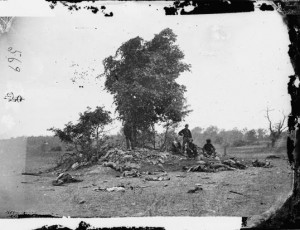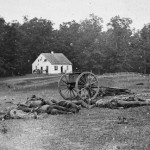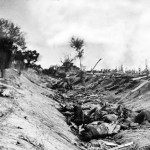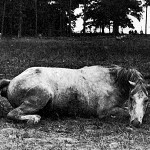 After the Battle of Antietam, the Union Army took time to lick its wounds. President Lincoln and many in the Washington command structure champed at the bit and wanted McClellan and the army in pursuit of the Confederates to follow up on the victory. McClellan, though, stood by his decision to rest his battered forces and regroup.
After the Battle of Antietam, the Union Army took time to lick its wounds. President Lincoln and many in the Washington command structure champed at the bit and wanted McClellan and the army in pursuit of the Confederates to follow up on the victory. McClellan, though, stood by his decision to rest his battered forces and regroup.
The men of the 19th Indiana and the Iron Brigade rejoiced at the break. They’d been roughly handled in their first three battles, and their numbers depleted drastically. Immediately after the battle the unit camped on the battlefield near the Dunker Church, their objective the morning of the battle. As the fortunate began to trickle in from the hospital, the survivors walked the fields, burying the dead men and feeding huge bonfires to burn the dead horses and mules; inky black smoke towered skywards for weeks afterwards while Gardner’s photographers walked the battlefield and photographed the carnage.
As they sat in camp, the army took stock of how much had actually been lost, and attempted to recruit replacements to fill in the ranks of the companies. Agents of the 19th Indiana back home recruited a few dozen men, but even a letter of recommendation from General McClellan himself, printed in local newspapers and extolling the record and courage of the 19th Indiana, failed to entice more. Reinforcement would have to come from elsewhere.
During the Civil War the majority of the Army was made up of volunteer state regiments. This was the day’s answer to the  lack of a large standing army in peacetime, and a direct descendant of the colonial local militia system. The states received a quota to fill from the President, the governors would appoint commanders to the new regiments, and those commanders would then recruit and fill the regiments. Finding replacements for existing units held little appeal to anyone, as there were no command appointments in it. Why go through the work of finding men for a unit that already had a commander? Much better to form your own unit, get the command, and all the glory and political clout attached to it. This is the reason that veteran units would operate at 20% or less of their full strength for most of their service: casualties were rarely replaced. The only realistic way to up the strength of the Iron Brigade and its four regiments was to add another regiment.
lack of a large standing army in peacetime, and a direct descendant of the colonial local militia system. The states received a quota to fill from the President, the governors would appoint commanders to the new regiments, and those commanders would then recruit and fill the regiments. Finding replacements for existing units held little appeal to anyone, as there were no command appointments in it. Why go through the work of finding men for a unit that already had a commander? Much better to form your own unit, get the command, and all the glory and political clout attached to it. This is the reason that veteran units would operate at 20% or less of their full strength for most of their service: casualties were rarely replaced. The only realistic way to up the strength of the Iron Brigade and its four regiments was to add another regiment.
Prior to Antietam, General McClellan had promised the Iron Brigade he would attach the next western regiment to muster into the Army of the Potomac. He kept his word and assigned the 24th Michigan to the unit on October 8th. The new regiment, never in battle, outnumbered the 19th Indiana and the 2nd, 6th and 7th Wisconsin regiments combined. The Michigan men were eager to get into battle, but the veterans had no such desire. Cornelius Wheeler, a veteran of the 2nd Wisconsin, wrote “We have had quite glory enough now,” and other soldiers wrote home saying that they hoped it would be a long time before they fought again, if ever.
 On September 29th, the brigade moved from the Dunker Church further west and to the shores of the Potomac. The battlefield reeked of death, even with burials and burning continuing day and night: most of the wells and streams in the immediate area were now polluted from the shallow graves and decaying animals, and during warm days it was impossible to breathe the air without a cloth over one’s mouth to keep out the stench and the swarms of flies. The residents of Sharpsburg also felt the full impact of the post-battle landscape. The Mumma family’s farm had been burned by North Carolina troops during the battle, so the buildings couldn’t be used as cover by the Union army. The Roulettes returned to find their barn and home used as a hospital, both buildings littered with body parts, the wood soaked in blood. The loss of their buildings was the least of the Roulettes’ concern, though, as two months later, their two year old daughter died of typhoid that she contracted from the army that remained camped around the battlefield and town. Even the wildlife felt the impact: locals reported that the sounds of birds and other animals frightened off by the fighting did not return until the arrival of spring in 1863. As October drew on, the men stayed in camp and received supplies. New clothing was issued: hats, jackets, pants, socks, canteens and cartridge boxes. Modifications were made to new hats and cartridge box belts: the brass eagle plates and other ornaments had proven handy aiming points for Rebel marksmen, and they were quickly torn off and discarded. Men were detailed to help in the camp’s kitchens, others were put to work gathering water, and the daily drill resumed, training to keep the veterans from thinking too much on what they’d seen, and to bring the new recruits of the 24th Michigan up to speed.
On September 29th, the brigade moved from the Dunker Church further west and to the shores of the Potomac. The battlefield reeked of death, even with burials and burning continuing day and night: most of the wells and streams in the immediate area were now polluted from the shallow graves and decaying animals, and during warm days it was impossible to breathe the air without a cloth over one’s mouth to keep out the stench and the swarms of flies. The residents of Sharpsburg also felt the full impact of the post-battle landscape. The Mumma family’s farm had been burned by North Carolina troops during the battle, so the buildings couldn’t be used as cover by the Union army. The Roulettes returned to find their barn and home used as a hospital, both buildings littered with body parts, the wood soaked in blood. The loss of their buildings was the least of the Roulettes’ concern, though, as two months later, their two year old daughter died of typhoid that she contracted from the army that remained camped around the battlefield and town. Even the wildlife felt the impact: locals reported that the sounds of birds and other animals frightened off by the fighting did not return until the arrival of spring in 1863. As October drew on, the men stayed in camp and received supplies. New clothing was issued: hats, jackets, pants, socks, canteens and cartridge boxes. Modifications were made to new hats and cartridge box belts: the brass eagle plates and other ornaments had proven handy aiming points for Rebel marksmen, and they were quickly torn off and discarded. Men were detailed to help in the camp’s kitchens, others were put to work gathering water, and the daily drill resumed, training to keep the veterans from thinking too much on what they’d seen, and to bring the new recruits of the 24th Michigan up to speed.
This life would continue on into November as the army moved back into Virginia, where the Iron Brigade would receive  bad news on two fronts. First, General Gibbon, the one who had outfit the unit in the distinctive tall black hats and regular army uniform, was promoted out of the unit. More than just clothing the men, his training and discipline that the men had initially chafed under had turned them into the fighting unit now famous in the eastern theatre. Then, just three days later on November 7th, tired of his inaction and failure to follow-up on the gains made at Antietam, President Lincoln relieved McClellan of command of the army. McClellan, always popular with the soldiers, received a tearful farewell at a final review on November 10th.
bad news on two fronts. First, General Gibbon, the one who had outfit the unit in the distinctive tall black hats and regular army uniform, was promoted out of the unit. More than just clothing the men, his training and discipline that the men had initially chafed under had turned them into the fighting unit now famous in the eastern theatre. Then, just three days later on November 7th, tired of his inaction and failure to follow-up on the gains made at Antietam, President Lincoln relieved McClellan of command of the army. McClellan, always popular with the soldiers, received a tearful farewell at a final review on November 10th.
As November closed, the army moved again, further south, now under command of General Burnside, headed for Fredericksburg.